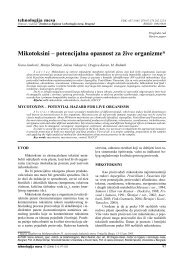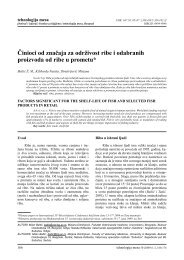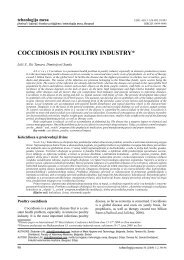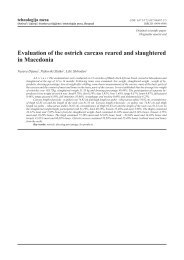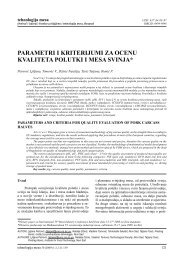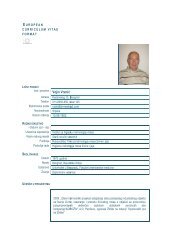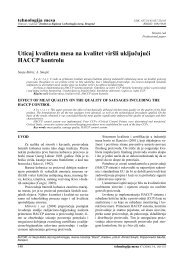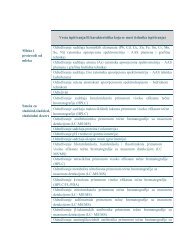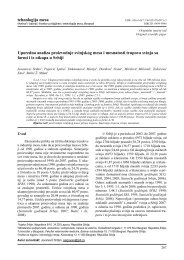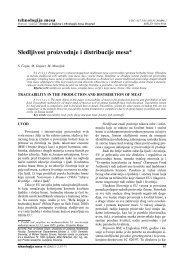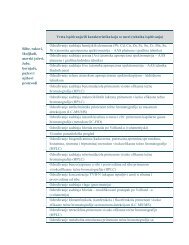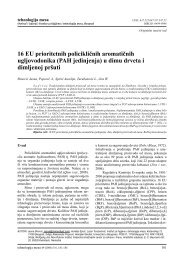The significance of rational use of drugs in ... - inmesbgd.com
The significance of rational use of drugs in ... - inmesbgd.com
The significance of rational use of drugs in ... - inmesbgd.com
You also want an ePaper? Increase the reach of your titles
YUMPU automatically turns print PDFs into web optimized ePapers that Google loves.
tehnologija mesa UDK: 64.9:615.3.07<br />
Ćupić Osnivač Vitomir i izdavač: Institut za higijenu i tehnologiju mesa, <strong>The</strong> <strong>significance</strong> Beograd <strong>of</strong> <strong>rational</strong> <strong>use</strong> <strong>of</strong> <strong>drugs</strong> <strong>in</strong> veter<strong>in</strong>ary medic<strong>in</strong>e BIBLID: for food 0494-9846 safety<br />
<strong>The</strong> <strong>significance</strong> <strong>of</strong> <strong>rational</strong> <strong>use</strong> <strong>of</strong> <strong>drugs</strong> <strong>in</strong> veter<strong>in</strong>ary<br />
medic<strong>in</strong>e for food safety*<br />
Ćupić Vitomir 1 , Dobrić Silva 2 , Antonijević Biljana 3 , Čelebićan<strong>in</strong> Sanja 4<br />
A b s t r a c t: Rational <strong>use</strong> <strong>of</strong> <strong>drugs</strong> <strong>in</strong> veter<strong>in</strong>ary medic<strong>in</strong>e has manifold <strong>significance</strong>. By us<strong>in</strong>g each drug, only when it is<br />
really necessary (<strong>in</strong>dicated), <strong>in</strong> right dose and route <strong>of</strong> adm<strong>in</strong>istration, the potential damage <strong>of</strong> their <strong>use</strong> is reduced, efficiency<br />
<strong>in</strong>creased, and the risk <strong>of</strong> microorganisms resistance development (<strong>in</strong> case <strong>of</strong> antimicrobials) significantly decreased. All <strong>of</strong> this<br />
be<strong>com</strong>es more important when these <strong>drugs</strong> are <strong>use</strong>d <strong>in</strong> food produc<strong>in</strong>g animals.<br />
Simultaneously with the <strong>in</strong>tensify<strong>in</strong>g <strong>of</strong> cattle breed<strong>in</strong>g and exceptional <strong>in</strong>crease <strong>of</strong> animal productivity, the number <strong>of</strong><br />
<strong>use</strong>d <strong>drugs</strong> is unavoidably <strong>in</strong>creased. <strong>The</strong>re are almost no animals today <strong>in</strong> <strong>in</strong>tensive as well as <strong>in</strong> extensive production/rear<strong>in</strong>g<br />
system, which haven’t received at least one drug dur<strong>in</strong>g their life.<br />
In poultry, cattle and pig production, which are ma<strong>in</strong> sectors for production <strong>of</strong> food stuffs <strong>of</strong> animal orig<strong>in</strong>, the <strong>use</strong> <strong>of</strong><br />
<strong>drugs</strong> has <strong>in</strong>creased and reached the limits which are considered alarm<strong>in</strong>g for health <strong>of</strong> people.<br />
On the first place are antibiotics, or antimicrobial <strong>drugs</strong>, which are <strong>use</strong>d very <strong>of</strong>ten <strong>in</strong> therapy or prevention <strong>of</strong> bacteria<br />
diseases, and also, very <strong>of</strong>ten, as growth stimulator. In addition to antibiotics, many other <strong>drugs</strong> are <strong>use</strong>d, with proven numerous<br />
harmful effects, even with carc<strong>in</strong>ogenic and teratogenic features, whose residues <strong>in</strong> food <strong>in</strong>tended for human consumption can<br />
very seriously endanger the health <strong>of</strong> people, as potential consumers <strong>of</strong> this k<strong>in</strong>d <strong>of</strong> food. <strong>The</strong>refore, the control <strong>of</strong> <strong>use</strong> <strong>of</strong><br />
antimicrobial, and other <strong>drugs</strong> <strong>in</strong> livestock production is exceptionally significant.<br />
Key words: non-<strong>rational</strong> <strong>use</strong> <strong>of</strong> <strong>drugs</strong>, antimicrobials, side effects, food produc<strong>in</strong>g animals.<br />
Introduction<br />
Non-<strong>rational</strong> <strong>use</strong> <strong>of</strong> <strong>drugs</strong> is a problem, which<br />
already existed for a long time <strong>in</strong> the cl<strong>in</strong>ical practice<br />
<strong>in</strong> human and veter<strong>in</strong>ary medic<strong>in</strong>e. Although this<br />
issue was on many occasions subject <strong>of</strong> discussion<br />
on numerous Symposiums and Congresses, it is still<br />
very current, maybe even more than before. First <strong>of</strong><br />
all, such <strong>use</strong> <strong>of</strong> <strong>drugs</strong> can easier ca<strong>use</strong> certa<strong>in</strong> harmful<br />
effects and damages <strong>in</strong> treated animals. Bear<strong>in</strong>g<br />
this <strong>in</strong> m<strong>in</strong>d, and also the fact that there aren’t any<br />
significant improvements <strong>in</strong> the cl<strong>in</strong>ical practice, we<br />
must devote much more time and attention to follow<br />
and control <strong>use</strong> <strong>of</strong> <strong>drugs</strong> on animals (Ćupić and<br />
Živanov, 1990).<br />
Non-<strong>rational</strong> <strong>use</strong> <strong>of</strong> <strong>drugs</strong> <strong>in</strong> veter<strong>in</strong>ary medic<strong>in</strong>e,<br />
as well as the need for control <strong>of</strong> their <strong>use</strong><br />
be<strong>com</strong>es even bigger problem when <strong>use</strong>d on food<br />
produc<strong>in</strong>g animals. In that case, there is the possibility<br />
that m<strong>in</strong>imal quantities <strong>of</strong> <strong>drugs</strong> and their metabolites<br />
(residues) which rema<strong>in</strong> <strong>in</strong> edible tissues,<br />
i.e. <strong>in</strong> animal products (meat, milk, eggs, honey)<br />
<strong>in</strong>duce certa<strong>in</strong> harmful effects <strong>in</strong> people as potential<br />
consumers <strong>of</strong> such food (Ćupić, 1997).<br />
We are witnesses that productivity <strong>in</strong> food produc<strong>in</strong>g<br />
animals has manifold <strong>in</strong>creased dur<strong>in</strong>g the<br />
last 50 years, first <strong>of</strong> all due to improvement <strong>of</strong> selection,<br />
veter<strong>in</strong>ary-medical care, as well as improvement<br />
<strong>of</strong> diet and good organization <strong>of</strong> production.<br />
With the help <strong>of</strong> these measures, which are permanently<br />
corrected and amended, even <strong>in</strong> the countries<br />
where they were brought to the perfection), animals<br />
became “real small factories“ for production <strong>of</strong> food.<br />
Simultaneously with atta<strong>in</strong><strong>in</strong>g <strong>of</strong> higher productivity<br />
<strong>of</strong> animals, the need for the decrease <strong>of</strong> their number<br />
occurred. Actually, only animals whose keep<strong>in</strong>g is<br />
economic pr<strong>of</strong>itable <strong>in</strong> production are reta<strong>in</strong>ed.<br />
*Plenary paper on International 56 th Meat Industry Conference held from June 12-15 th 2011. Tara mounta<strong>in</strong>;<br />
*Plenarno predavanje na Međunarodnom 56. savetovanju <strong>in</strong>dustrije mesa, održanom od 12-15. juna 2011.<br />
god<strong>in</strong>e na Tari.<br />
1<br />
Univerzitet u Beogradu, Fakultet veter<strong>in</strong>arske medic<strong>in</strong>e, Bulevar oslobođenja 18, 11000 Beograd, Republika Srbija;<br />
2<br />
Vojnomedic<strong>in</strong>ska akademija, Crnotravska, 17, 11000 Beograd, Republika Srbija;<br />
3<br />
Univerzitet u Beogradu, Farmaceutski fakultet, Vojvode Stepe 455, Beograd, Republika Srbija;<br />
4<br />
Uprava za veter<strong>in</strong>u, M<strong>in</strong>istarstvo za poljoprivredu, šumarstvo i vodoprivredu Republike Srbije, 11000 Beograd, Republika Srbija.<br />
Correspond<strong>in</strong>g author: Ćupić Vitomir, cpcv@Eunet.rs<br />
74
Tehnologija mesa 52 (2011) 1, 74–79<br />
Evidence <strong>of</strong> <strong>in</strong>crease <strong>of</strong> animal productivity<br />
over time can be illustrated <strong>in</strong> the follow<strong>in</strong>g example:<br />
<strong>in</strong> 1928 year, <strong>in</strong> poultry rear<strong>in</strong>g (broilers), <strong>in</strong><br />
order to reach the <strong>com</strong>mercial weight <strong>of</strong> 1,7 kg per<br />
unit, 112 days were necessary and birds needed to<br />
consume about 22 kg <strong>of</strong> food, <strong>in</strong> average; <strong>in</strong> 1990,<br />
broiler reach the weight <strong>of</strong> 2 kg <strong>in</strong> 42 days by consum<strong>in</strong>g<br />
only 4 kg <strong>of</strong> food per one unit/animal. In the<br />
1930-ties, hens laid 93 eggs per year, <strong>in</strong> the 1950-ties<br />
174, and <strong>in</strong> 1993 252 eggs yearly.<br />
Similar example exists <strong>in</strong> production <strong>of</strong> cow<br />
milk. In USA, for example, with the decrease <strong>of</strong> dairy<br />
cows, there was the <strong>in</strong>crease <strong>of</strong> milk production,<br />
due to the <strong>in</strong>crease <strong>of</strong> milk yield per cow. In <strong>com</strong>parison<br />
to year 1983, when milk yield <strong>in</strong> USA amounted<br />
to 5.598 kg/cow <strong>in</strong> average, <strong>in</strong> 1995, milk yield<br />
<strong>in</strong>creased to 7.478 kg/cow, etc.<br />
One <strong>of</strong> measures, which besides others, no doubt,<br />
contributed to higher the productivity <strong>of</strong> animals<br />
was veter<strong>in</strong>ary-medical care <strong>in</strong> animal production.<br />
First <strong>of</strong> all, it is reflected <strong>in</strong> the efficiency <strong>of</strong> prevention<br />
<strong>of</strong> different animal diseases, and understand<strong>in</strong>g <strong>of</strong><br />
the <strong>use</strong> <strong>of</strong> different vacc<strong>in</strong>es and others prophylactic<br />
remedies. Also, not less significant was the role <strong>of</strong><br />
antibiotics, i.e. antimicrobial <strong>drugs</strong> and anti-parasitic<br />
<strong>drugs</strong>, which are <strong>use</strong>d ma<strong>in</strong>ly <strong>in</strong> therapy, but also for<br />
prevention <strong>of</strong> diseases, as well as <strong>drugs</strong> which are<br />
<strong>use</strong>d as growth stimulators, among which the most<br />
frequent are hormones and some antimicrobials<br />
(Adams, 2001; Brander et al., 1991).<br />
<strong>The</strong> <strong>use</strong> <strong>of</strong> antimicrobial <strong>drugs</strong> <strong>in</strong> animals attracts<br />
special attention. In therapy <strong>of</strong> diseases <strong>of</strong><br />
bacterial etiology they are certa<strong>in</strong>ly <strong>in</strong>dicated and <strong>in</strong><br />
those k<strong>in</strong>ds <strong>of</strong> cases their <strong>use</strong> is justified, it is better to<br />
say <strong>rational</strong>, regardless <strong>of</strong> all hazards due to residues<br />
<strong>of</strong> these <strong>drugs</strong> <strong>in</strong> food stuffs consumed by humans<br />
(Giguere et al., 2006).<br />
Namely, it is considered that damage <strong>in</strong> untreated<br />
animals could be much higher, than short-term<br />
<strong>in</strong>ability to <strong>use</strong> food stuffs (obta<strong>in</strong>ed from such<br />
animals) <strong>in</strong> determ<strong>in</strong>ed period subsequent to therapy,<br />
depend<strong>in</strong>g on the withdrawal period. Prophylactic<br />
<strong>use</strong> <strong>of</strong> antimicrobial <strong>drugs</strong> or <strong>use</strong> <strong>of</strong> these<br />
<strong>drugs</strong> for the purpose <strong>of</strong> growth stimulation <strong>in</strong> animals<br />
understands giv<strong>in</strong>g <strong>of</strong> smaller doses than therapeutic<br />
<strong>of</strong> antimicrobial <strong>drugs</strong>. <strong>The</strong>reby, with this<br />
k<strong>in</strong>d <strong>of</strong> drug <strong>use</strong>, the risk from <strong>in</strong>cidence <strong>of</strong> diseases<br />
bacteria etiology is decreased and utilization <strong>of</strong><br />
food improved and growth stimulated. However,<br />
subsequent to such <strong>use</strong> <strong>of</strong> antimicrobial <strong>drugs</strong> simultaneously<br />
the risk <strong>of</strong> <strong>in</strong>cidence <strong>of</strong> undesirable<br />
effects <strong>in</strong>creases considerably. First <strong>of</strong> all, rate <strong>of</strong><br />
development <strong>of</strong> resistance <strong>of</strong> bacteria to <strong>use</strong>d antimicrobial<br />
<strong>drugs</strong> is <strong>in</strong>creased (Ašan<strong>in</strong> et al., 2005)<br />
and certa<strong>in</strong>ly risk from residues <strong>in</strong> animal food stuffs<br />
<strong>in</strong>tended for human consumption is higher than<br />
when antimicrobials are <strong>use</strong>d only <strong>in</strong> therapeutic<br />
purposes (Sanders, 2007; Spirić et al., 2007). Beca<strong>use</strong><br />
<strong>of</strong> this reason, <strong>in</strong> our country, maximum care is<br />
taken so that antimicrobials are not <strong>use</strong>d <strong>in</strong> prophylactic<br />
purposes, but only <strong>in</strong> therapeutic, as well as<br />
that they are not <strong>use</strong>d for stimulation <strong>of</strong> growth <strong>in</strong><br />
animals (Ćupić et al., 1997).<br />
Rational <strong>use</strong> <strong>of</strong> antimicrobial <strong>drugs</strong><br />
Nowadays, <strong>in</strong> the cl<strong>in</strong>ical practice <strong>of</strong> human<br />
and veter<strong>in</strong>ary medic<strong>in</strong>e throughout the world a large<br />
number <strong>of</strong> antimicrobial <strong>drugs</strong> are <strong>use</strong>d. Likewise<br />
many scientists <strong>in</strong>tensively work on discovery and<br />
synthesis <strong>of</strong> new <strong>drugs</strong> with broader antimicrobial<br />
spectrum, stronger action and more satisfactory safety<br />
pr<strong>of</strong>ile. Unfortunately we are witnesses <strong>of</strong> rather<br />
non-<strong>rational</strong> <strong>use</strong> <strong>of</strong> these <strong>drugs</strong>. Despite constant<br />
<strong>in</strong>dicat<strong>in</strong>g <strong>of</strong> all failures and harmful effects <strong>of</strong> such<br />
<strong>use</strong>, it is present <strong>in</strong> every-day cl<strong>in</strong>ical practice.<br />
Most mistakes dur<strong>in</strong>g antimicrobial therapy<br />
may occur when pathogenic microorganism is unknown<br />
and therapy starts empirically. Most <strong>of</strong>ten<br />
<strong>com</strong>b<strong>in</strong>ations <strong>of</strong> two or more antibiotic <strong>drugs</strong> are<br />
<strong>use</strong>d. To avoid these mistakes, cl<strong>in</strong>ically confirmed,<br />
effective antibiotic <strong>com</strong>b<strong>in</strong>ations should be <strong>use</strong>d.<br />
<strong>The</strong>se <strong>com</strong>b<strong>in</strong>ations are <strong>use</strong>ful <strong>in</strong> treat<strong>in</strong>g serious<br />
<strong>in</strong>fections, mixed bacterial <strong>in</strong>fections, when resistance<br />
occurs enzymatic destruction <strong>of</strong> a drug, and <strong>in</strong> order<br />
to reduce toxicity (Giguere et al., 2006).<br />
Unwanted effects <strong>of</strong> antimicrobial <strong>drugs</strong><br />
Unwanted effects <strong>of</strong> antimicrobial <strong>drugs</strong> can<br />
be quite mild and pass <strong>in</strong> a form <strong>of</strong> quite slight<br />
disturbances, then also unexpected reactions may<br />
appear, (such as idiosyncratic or allergic reactions,<br />
even anaphylactic shock), as well as different damages<br />
to the function <strong>of</strong> organs. Sometimes, non<strong>rational</strong><br />
<strong>use</strong> <strong>of</strong> <strong>drugs</strong>, can provoke the most serious<br />
disturbances, as are mutagenesis, carc<strong>in</strong>ogenesis and<br />
teratogenesis. Beca<strong>use</strong> <strong>of</strong> all <strong>of</strong> this, today, <strong>in</strong> cl<strong>in</strong>ical<br />
practice we must be very careful and consider<br />
frequency <strong>of</strong> application and dose <strong>of</strong> these <strong>drugs</strong>,<br />
and also possible side effects, which some <strong>of</strong> these<br />
<strong>drugs</strong> can provoke, and especially <strong>in</strong> case <strong>of</strong> those<br />
<strong>drugs</strong> which are banned (beca<strong>use</strong> <strong>of</strong> proved toxicity),<br />
(Ćupić and Živanov, 1990; Giguere et al., 2006;<br />
Ćupić and Dobrić, 2003).<br />
Forbidden antimicrobial and other <strong>drugs</strong> for<br />
<strong>use</strong> <strong>in</strong> food produc<strong>in</strong>g animals<br />
Beca<strong>use</strong> <strong>of</strong> their toxicity, for animals alone<br />
(to whom they are applied), and also for people,<br />
potential consumers <strong>of</strong> products, which derived from<br />
75
Ćupić Vitomir<br />
<strong>The</strong> <strong>significance</strong> <strong>of</strong> <strong>rational</strong> <strong>use</strong> <strong>of</strong> <strong>drugs</strong> <strong>in</strong> veter<strong>in</strong>ary medic<strong>in</strong>e for food safety<br />
such animals, Food and Drug Adm<strong>in</strong>istration (FDA)<br />
banned the <strong>use</strong> <strong>of</strong> some antimicrobials, as well as<br />
other <strong>drugs</strong> <strong>in</strong> food animals. Those are: chloramphenicol,<br />
nitroimidazoles, nitr<strong>of</strong>urans, qu<strong>in</strong>oxal<strong>in</strong>es,<br />
fluoroqu<strong>in</strong>olones, sulfonamides, glycopeptides, ionophors,<br />
cephalospor<strong>in</strong>s, diethylstilbestrol, dypirone,<br />
phenylbutazone, clenbuterol and some antiviral<br />
<strong>drugs</strong> <strong>in</strong> poultry (Payne et al., 1999; Davis et al.,<br />
2009).<br />
Some <strong>of</strong> the mentioned <strong>drugs</strong> (majority)<br />
FDA prohibited <strong>com</strong>pletely, and some <strong>of</strong> them are<br />
prohibited as extra label <strong>drugs</strong>, which means that<br />
when a drug is <strong>use</strong>d <strong>in</strong> a manner that is not <strong>in</strong> accordance<br />
with the FDA approved label, or Instruction.<br />
This <strong>in</strong>cludes <strong>use</strong> <strong>in</strong> a species or for a disease<br />
or condition not listed on the label; <strong>use</strong> at dosages,<br />
frequencies or routes <strong>of</strong> adm<strong>in</strong>istration that differ<br />
from those stated on the label; or deviation from the<br />
labeled withdrawal time. Accord<strong>in</strong>g to AMDUCA<br />
(Animal Medic<strong>in</strong>al Drug Clarification Act) from<br />
the year 2010, all <strong>of</strong> the aforementioned <strong>drugs</strong> now<br />
are <strong>com</strong>pletely prohibited for <strong>use</strong> <strong>in</strong> food animals<br />
(AMDUCA, 2010).<br />
Chloramphenicol - This drug is forbidden s<strong>in</strong>ce<br />
the year 1984, beca<strong>use</strong> it can ca<strong>use</strong> (although rarely)<br />
idiosyncratic (non dose dependent, irreversible) aplastic<br />
anemia <strong>in</strong> people. Likewise, the <strong>use</strong> <strong>of</strong> all preparations<br />
<strong>in</strong>clud<strong>in</strong>g ophthalmic o<strong>in</strong>tments, or spray<br />
for wounds <strong>in</strong> food produc<strong>in</strong>g animals is forbidden.<br />
However, the newer members <strong>of</strong> amphenicols like<br />
florfenicol or tiamfenicol are allowed. Florfenicol is<br />
available for <strong>use</strong> <strong>in</strong> cattle, sw<strong>in</strong>e, and some aquatic<br />
species (Davis et al, 2009; Payne et al., 1999).<br />
Nitroimidazoles - All members <strong>of</strong> this group<br />
(<strong>in</strong>clud<strong>in</strong>g dimetridazole, metronidazole, ronidazole,<br />
tnidazole and ipronidazole) are forbidden beca<strong>use</strong><br />
<strong>of</strong> their <strong>in</strong> vitro and <strong>in</strong> vivo carc<strong>in</strong>ogenic properties.<br />
Although they are <strong>use</strong>d <strong>in</strong> humans and <strong>com</strong>panion<br />
animals, the <strong>use</strong> <strong>of</strong> any drug from this group <strong>in</strong> food<br />
produc<strong>in</strong>g animals is illegal (Payne et al., 1999).<br />
Nitr<strong>of</strong>urans - <strong>The</strong>se <strong>drugs</strong> are also forbidden<br />
beca<strong>use</strong> <strong>of</strong> carc<strong>in</strong>ogenicity and mutagenicity (Payne<br />
et al., 1999; Batas et al., 2007). <strong>The</strong> <strong>use</strong> <strong>of</strong> these<br />
<strong>drugs</strong> for therapy <strong>of</strong> systemic <strong>in</strong>fections <strong>in</strong> human<br />
medic<strong>in</strong>e was withdrawn <strong>in</strong> 1974 and for treatment<br />
<strong>of</strong> systemic <strong>in</strong>fection <strong>in</strong> veter<strong>in</strong>ary medic<strong>in</strong>e was<br />
banned <strong>in</strong> 1991. Later studies have documented that<br />
topical application <strong>of</strong> these <strong>drugs</strong> for therapy <strong>of</strong> eye<br />
or surface wounds <strong>in</strong> cattle, sheep and goats, also<br />
results <strong>in</strong> milk and meat residues. Beca<strong>use</strong> <strong>of</strong> that,<br />
FDA prohibited the <strong>use</strong> <strong>of</strong> topical nitr<strong>of</strong>urans <strong>in</strong>tended<br />
for human and veter<strong>in</strong>ary medic<strong>in</strong>e <strong>in</strong> food<br />
produc<strong>in</strong>g animals (Smith et al., 1998). S<strong>in</strong>ce year<br />
2002, all systemic and topical <strong>use</strong> <strong>of</strong> nitr<strong>of</strong>uran products<br />
has been prohibited (US FDA Web site, 2009).<br />
Qu<strong>in</strong>oxal<strong>in</strong>es - It has been known for a long<br />
time that qu<strong>in</strong>oxal<strong>in</strong>es (carbadox, olaqu<strong>in</strong>dox and<br />
cydox) are carc<strong>in</strong>ogenic <strong>com</strong>pounds. Beca<strong>use</strong> <strong>of</strong><br />
that, many countries have forbidden or withdrawn<br />
these <strong>drugs</strong> from <strong>use</strong> (Payne et al., 1999).<br />
Fluoroqu<strong>in</strong>olones - <strong>The</strong>se <strong>drugs</strong> became <strong>in</strong>terest<strong>in</strong>g,<br />
beca<strong>use</strong> it was shown that they stimulate<br />
development <strong>of</strong> bacterial resistance. <strong>The</strong> best <strong>in</strong>stance<br />
are resistant salmonellosis <strong>in</strong>fections <strong>in</strong> humans.<br />
<strong>The</strong>refore, the <strong>use</strong> <strong>of</strong> fluoroqu<strong>in</strong>olones <strong>in</strong>tended for<br />
humans is banned s<strong>in</strong>ce 1997, as well as their <strong>use</strong> <strong>in</strong><br />
food produc<strong>in</strong>g animals. So, the <strong>use</strong> <strong>of</strong> enr<strong>of</strong>loxac<strong>in</strong><br />
is banned <strong>in</strong> all food produc<strong>in</strong>g animals, except <strong>in</strong><br />
calves and heifers. Precisely this drug may not be<br />
<strong>use</strong>d <strong>in</strong> cows <strong>in</strong> period <strong>of</strong> lactation or dry period,<br />
heifers, dairy calves, ewes, goats and deer. Also,<br />
beca<strong>use</strong> <strong>of</strong> that, enr<strong>of</strong>loxac<strong>in</strong> may not be stored <strong>in</strong><br />
dairy farm drug cab<strong>in</strong>ets (Payne et al., 1999).<br />
Sulfonamides - Sulfonamides have been banned<br />
<strong>in</strong> adult dairy cows. Adult dairy cows are def<strong>in</strong>ed<br />
as any dairy cow over 20 months <strong>of</strong> age,<br />
regardless <strong>of</strong> milk<strong>in</strong>g status. This ban was <strong>in</strong>stituted<br />
beca<strong>use</strong> <strong>of</strong> the concern over carc<strong>in</strong>ogenic effects<br />
detected <strong>in</strong> laboratory animals, which co<strong>in</strong>cided<br />
with reports <strong>of</strong> sulfonamide residues detected <strong>in</strong><br />
up to 73% <strong>of</strong> <strong>com</strong>mercial milk samples. Only 1 <strong>of</strong><br />
the 3 sulfonamides that have label <strong>in</strong>dications for<br />
lactat<strong>in</strong>g cows, sulfadimethox<strong>in</strong>e (SDM) is currently<br />
be<strong>in</strong>g marketed. Currently, <strong>use</strong> <strong>of</strong> any sulfonamide<br />
other than SDM <strong>in</strong> dairy cattle older than 20 months<br />
is illegal. Additionally, extralabel <strong>use</strong> <strong>of</strong> SDM <strong>in</strong><br />
lactat<strong>in</strong>g dairy cattle is prohibited (for example <strong>use</strong><br />
<strong>of</strong> a higher dose or slow-release SDM bol<strong>use</strong>s <strong>in</strong><br />
dairy cattle is not permitted), (Payne et al., 1999;<br />
Davis et al, 2009).<br />
Glycopeptides - <strong>The</strong> only glycopeptide antibiotic<br />
available <strong>in</strong> the United States is the human<br />
product van<strong>com</strong>yc<strong>in</strong>. Van<strong>com</strong>yc<strong>in</strong> is <strong>of</strong>ten <strong>use</strong>d for<br />
the treatment methicill<strong>in</strong>-resistant Staphylococcus<br />
aureus <strong>in</strong>fections <strong>in</strong> humans. Avoparc<strong>in</strong>, a <strong>com</strong>pound<br />
chemically similar to van<strong>com</strong>yc<strong>in</strong>, has been <strong>use</strong>d <strong>in</strong><br />
European animal feeds as a growth promoter s<strong>in</strong>ce<br />
the mid 1970s. FDA <strong>in</strong> 1977 issued an order prohibit<strong>in</strong>g<br />
the extra label <strong>use</strong> <strong>of</strong> all glycopeptides <strong>in</strong> food<br />
produc<strong>in</strong>g animals. <strong>The</strong> restriction <strong>of</strong> fluoroqu<strong>in</strong>olone<br />
and glycopeptide <strong>use</strong> represents a novel exercise<br />
<strong>of</strong> FDA discretionary authority: restriction based<br />
not on the <strong>drugs</strong> direct toxicity, but on its potential<br />
for <strong>in</strong>creas<strong>in</strong>g human pathogen resistance (Jung et<br />
al., 2007; Klare et al., 2003; Song et al., 2005).<br />
Ionophors- <strong>The</strong> <strong>use</strong> <strong>of</strong> ionophore antibiotics<br />
such as monens<strong>in</strong> and lasalocid is banned <strong>in</strong> lactat<strong>in</strong>g<br />
dairy. This is valid also for ewes and goats <strong>in</strong><br />
period <strong>of</strong> lactation (Payne et al., 1999).<br />
76
Tehnologija mesa 52 (2011) 1, 74–79<br />
Cephalospor<strong>in</strong>s - In July 2008, FDA proposed<br />
prohibition on extra label <strong>use</strong> <strong>of</strong> cephalospor<strong>in</strong>s <strong>in</strong><br />
food produc<strong>in</strong>g animals, beca<strong>use</strong> <strong>of</strong> the <strong>in</strong>creased<br />
<strong>in</strong>cidence <strong>of</strong> cephalospor<strong>in</strong>-resistant food-borne<br />
pathogens, particularly Salmonella spp. Monitor<strong>in</strong>g<br />
system revealed an <strong>in</strong>crease <strong>in</strong> resistance <strong>of</strong> Salmonella<br />
isolates from both humans and food-<br />
-produc<strong>in</strong>g animals to cefti<strong>of</strong>ur, a member <strong>of</strong> third-<br />
-generation cephalospor<strong>in</strong> drug marketed for <strong>use</strong><br />
<strong>in</strong> cattle, sheep, dairy goats, and sw<strong>in</strong>e as multiple<br />
<strong>in</strong>jectable formulations as well as <strong>in</strong>tramammary<br />
preparations for lactat<strong>in</strong>g and non-lactat<strong>in</strong>g cows<br />
(US FDA Web site, 2009).<br />
Diethylstilbestrol - This drug is forbidden <strong>in</strong><br />
food produc<strong>in</strong>g animals s<strong>in</strong>ce 1979, beca<strong>use</strong> <strong>of</strong> its<br />
carc<strong>in</strong>ogenic potential. Namely, it was recorded<br />
that <strong>in</strong> pregnant women it provokes development<br />
<strong>of</strong> reproductive tract abnormalities and tumors <strong>in</strong><br />
female <strong>of</strong>fspr<strong>in</strong>g <strong>of</strong> diethylstilbestrol treated patients<br />
(Newbold, 2008).<br />
Dipyrone- It is known that dipyrone is drug<br />
which belongs to the large group <strong>of</strong> Nesteroidal-<br />
-anti-<strong>in</strong>flammatory <strong>drugs</strong>. However, it was recorded<br />
that this drug, <strong>in</strong> addition to the anti-<strong>in</strong>flammatory,<br />
antipyretic and analgesic action, also <strong>in</strong>duces very<br />
toxic effects <strong>in</strong> humans (non-dose dependent terratogenic<br />
effects, prolonged bleed<strong>in</strong>g times and agranulocytosis).<br />
Beca<strong>use</strong> <strong>of</strong> that FDA abolished its <strong>use</strong><br />
and withdrew this drug from the market <strong>in</strong> 1977,<br />
while its <strong>use</strong> <strong>in</strong> the veter<strong>in</strong>ary medic<strong>in</strong>e was first<br />
abolished <strong>in</strong> small non-food-produc<strong>in</strong>g animals <strong>in</strong><br />
1995, with suggestion that this must be <strong>in</strong>stituted<br />
<strong>in</strong> all food-produc<strong>in</strong>g animals also. Today, <strong>use</strong> <strong>of</strong><br />
dypirone <strong>in</strong> any food produc<strong>in</strong>g animal is considered<br />
illegal (Center for food Safety and Applied Nutrition<br />
Web Site, 2009).<br />
Phenylbutazone - Phenylbutazone (as sulfonamides)<br />
<strong>in</strong> dairy cattle over 20 months <strong>of</strong> age was<br />
prohibited <strong>in</strong> 2003. This was based on detection <strong>of</strong><br />
phenylbutazone residues <strong>in</strong> culled dairy cattle and<br />
the discovery <strong>of</strong> phenylbutazone products on dairy<br />
farms. It is considered that phenylbutazone <strong>in</strong> humans<br />
can <strong>in</strong>duce blood dyscrasis (such as aplastic<br />
anemia, leucopenia, agranulocytosis and thrombocytopenia)<br />
and ca<strong>use</strong> death. It is also considered a carc<strong>in</strong>ogen.<br />
Beca<strong>use</strong> <strong>of</strong> that, currently phenylbutazone<br />
<strong>use</strong> is strictly prohibited only <strong>in</strong> dairy cattle over 20<br />
months <strong>of</strong> age (New animal <strong>drugs</strong>, 2003).<br />
Clenbuterol - This drug is known bronchodilatator<br />
which acts on the β-adrenergic receptors<br />
<strong>in</strong> bronchial tree. As that k<strong>in</strong>d <strong>of</strong> drug, its <strong>use</strong> is<br />
allowed <strong>in</strong> horses, but <strong>in</strong> cattle and sheep it can<br />
provoke relaxation <strong>of</strong> uteri miometrium. Also, it has<br />
secondary anabolic effects. Beca<strong>use</strong> <strong>of</strong> this anabolic<br />
effect it was <strong>use</strong>d illegally for stimulation <strong>of</strong> growth<br />
<strong>in</strong> food animals <strong>in</strong>tended for humans, and for <strong>in</strong>crease<br />
<strong>of</strong> lean body mass and weight ga<strong>in</strong> <strong>in</strong> humans.<br />
However, <strong>in</strong> order to atta<strong>in</strong> these effects, high doses<br />
<strong>of</strong> this drug are needed. High doses usually provoke<br />
adverse effects <strong>in</strong> humans. <strong>The</strong>re are reports from<br />
Spa<strong>in</strong>, France, Italy, Portugal and other countries <strong>in</strong><br />
humans who consumed liver <strong>of</strong> treated cattle and<br />
lambs, and many people were hospitalized, and<br />
some <strong>of</strong> them died (Payne et al., 1999; Salleras et al,<br />
1995; Barbosa et al., 2005; Brambilla et al., 2000).<br />
Antiviral <strong>drugs</strong> <strong>in</strong> poultry - Two classes <strong>of</strong><br />
antiviral <strong>drugs</strong> currently marketed for <strong>use</strong> <strong>in</strong> humans<br />
have been added to the list <strong>of</strong> prohibited <strong>drugs</strong> <strong>in</strong><br />
poultry (US FDA Web Site, 2009). <strong>The</strong>se are the<br />
adamant<strong>in</strong>e <strong>in</strong>hibitors, rimantad<strong>in</strong>e and amantad<strong>in</strong>e,<br />
as well as the neuram<strong>in</strong>idase <strong>in</strong>hibitors, oseltamivir<br />
and zanamivir. <strong>The</strong>se antiviral <strong>drugs</strong> have been <strong>use</strong>d<br />
<strong>in</strong> countries outside the United States to treat or<br />
prevent the development and spread <strong>of</strong> avian <strong>in</strong>fluenza<br />
<strong>in</strong> poultry. <strong>The</strong> prohibition extends specifically<br />
to chickens, turkeys, and ducks. <strong>The</strong> prohibition<br />
order is based on the potential for the development<br />
<strong>of</strong> resistance to these <strong>com</strong>pounds (Parry, 2005; He<br />
et al., 2008; Cyranoski, 2005).<br />
Forbidden antimicrobial <strong>drugs</strong> for <strong>use</strong> <strong>in</strong><br />
food animals (present situation <strong>in</strong> Serbia)<br />
Accord<strong>in</strong>g to the proposal <strong>of</strong> the Medic<strong>in</strong>es<br />
and Medical Devices Agency, (published <strong>in</strong> Official<br />
Journal, No. 96/09), the follow<strong>in</strong>g antimicrobial<br />
<strong>drugs</strong> are prohibited <strong>in</strong> Republic <strong>of</strong> Seriba:<br />
qu<strong>in</strong>axal<strong>in</strong>es, nitr<strong>of</strong>urans, nitroimidazoles, glycopeptides,<br />
sulfonamides <strong>in</strong> adult dairy cows, fluoroqu<strong>in</strong>olones)<br />
(Official Journal <strong>of</strong> RS, 2009).<br />
Conclusions<br />
When <strong>drugs</strong> are <strong>use</strong>d <strong>in</strong> animals which are<br />
<strong>in</strong>tended for humans, then there is possibility for<br />
produc<strong>in</strong>g adverse effects <strong>in</strong> humans as potential<br />
consuments <strong>of</strong> food, org<strong>in</strong>at<strong>in</strong>g from treated animals.<br />
To prevent this possibility it is necessary to<br />
<strong>rational</strong>ly <strong>use</strong> <strong>drugs</strong>, i.e. to <strong>use</strong> them only when<br />
they are really <strong>in</strong>dicated, <strong>in</strong> the right way, right<br />
time and <strong>in</strong> the right dose. Also, it should respect<br />
withdrawal period, permanently follow, register and<br />
announce all about adverse effects after <strong>use</strong> <strong>of</strong> any<br />
drug, regularly control sensibility <strong>of</strong> bacteria to antimicrobial<br />
agents, and regularly control residues <strong>of</strong><br />
antimicrobials <strong>com</strong>mon <strong>use</strong>d <strong>in</strong> cl<strong>in</strong>ical practice.<br />
F<strong>in</strong>ally, hav<strong>in</strong>g <strong>in</strong> m<strong>in</strong>d that our country is <strong>in</strong><br />
transition, and aspir<strong>in</strong>g to be<strong>com</strong>e EU member, as<br />
soon as possible justifies further discussions and<br />
studies <strong>of</strong> this topic.<br />
77
Ćupić Vitomir<br />
References<br />
Adams H. R., 2001.Veter<strong>in</strong>ary Pharmacology and <strong>The</strong>rapeutics.<br />
Iowa State University Press/Ames. 8 th Edition.<br />
Anonymous, 2010. AMDUCA, Title 21-food and <strong>drugs</strong>. chapter<br />
i--food and drug adm<strong>in</strong>istration, department <strong>of</strong> health<br />
and human services (cont<strong>in</strong>ued).<br />
Anonymous, 2009. Center for Food Safety and Applied Nutrition<br />
Web site. CVM announces op<strong>in</strong>ion on dypirone<br />
products.<br />
Anonymous. 2003. New animal <strong>drugs</strong>; phenylbutazone; extralabel<br />
animal drug <strong>use</strong>; order <strong>of</strong> prohibition. Fed Regist<br />
68, 9528–9530.<br />
Anonymous, 2009. US FDA Web Site. FDA prohibits nitr<strong>of</strong>uran<br />
drug <strong>use</strong> <strong>in</strong> food-produc<strong>in</strong>g animals.<br />
Anonymous, 2009. US FDA Web Site. FDA prohibits <strong>use</strong> <strong>of</strong><br />
antiviral <strong>drugs</strong> <strong>in</strong> poultry to help keep <strong>drugs</strong> effective for<br />
humans.<br />
Anonymous, 2009. Službeni glasnik R. Srbije, broj 96.<br />
Anonymous, 2005. US FDA Web Site. NARMS executive<br />
report.<br />
Anonymous, 1999. Board <strong>of</strong> Agriculture (BOA). <strong>The</strong> <strong>use</strong> <strong>of</strong><br />
<strong>drugs</strong> <strong>in</strong> food animals: Benefits and risks. <strong>The</strong> National<br />
<strong>of</strong> Academies Press.<br />
Ašan<strong>in</strong> R., Mišić D., Krnjajić D., 2005. Značaj monitor<strong>in</strong>ga<br />
rezistencije bakterija na antimikrobna sredstva. Tehnologija<br />
mesa, 1–2, 75–79.<br />
Barbosa J., Cruz C., Marr<strong>in</strong>s J., 2005. Food poison<strong>in</strong>g by<br />
clenbuterol <strong>in</strong> Portugal. Food Addit. Contam 22, 563–<br />
566.<br />
Batas V., Spirić A., Petronijević R., Janković S., Miličević<br />
D., 2007. Određivanje metabolita nitr<strong>of</strong>urana u tkivima<br />
život<strong>in</strong>ja i primarnim proizvodima život<strong>in</strong>jskog porekla<br />
primenom tečne hromatografije sa masenom detekcijom<br />
(LC-MS/MS). Tehnologija mesa, 5–6, 242–249.<br />
Branbilla G., Cenci T., Franconi F., 2000. Cl<strong>in</strong>ical and<br />
pharmacological pr<strong>of</strong>ile <strong>in</strong> a clenbuterol epidemic poison<strong>in</strong>g<br />
<strong>of</strong> contam<strong>in</strong>ated beef meat <strong>in</strong> Italy. Toxicol Lett.,<br />
114, 47–53.<br />
Brander G. C., Pugh D. M., Bywater R. J., Jenk<strong>in</strong>s W. L.,<br />
1991.Veter<strong>in</strong>ary Applied Pharmacology and <strong>The</strong>rapeutics.<br />
5th Edition. London: Bailliere T<strong>in</strong>dall.<br />
Cyranovski D., 2005. Ch<strong>in</strong>a’s chicken farmers under fire for<br />
antiviral ab<strong>use</strong>. Nature, 435, 1009.<br />
Ćupić V., 1997. Zaostaci lekova u jestivim tkivima život<strong>in</strong>ja.<br />
Beograd.<br />
Ćupić V., Živanov D., 1990. Sporedna i neželjena dejstva<br />
lekova. Veter<strong>in</strong>arski glasnik, 46, 9, 13–517.<br />
<strong>The</strong> <strong>significance</strong> <strong>of</strong> <strong>rational</strong> <strong>use</strong> <strong>of</strong> <strong>drugs</strong> <strong>in</strong> veter<strong>in</strong>ary medic<strong>in</strong>e for food safety<br />
Ćupić V., Dobrić S., 2003. Sadašnje stanje i perspektive u<br />
razvoju antimikrobnih lekova. Veter<strong>in</strong>arski žurnal Republike<br />
Srpske, 2, 1–2, 36–42.<br />
Davis J., Smith G. W., Baynes R. E., Tell L. A., Webb A. I.,<br />
Riviere J. E., 2009. Update on <strong>drugs</strong> prohibited from<br />
extralabel <strong>use</strong> <strong>in</strong> food animals. Journal <strong>of</strong> American<br />
Veter<strong>in</strong>ary Medical Association, 235, 5, 528–34.<br />
Dresser L. D., Rybak M. J. 1998. <strong>The</strong> pharmacologic and bacteriologic<br />
properties <strong>of</strong> oxazolid<strong>in</strong>ones, a new class <strong>of</strong><br />
synthetic antimicrobials. Pharmacotherapy, 18, 456–462.<br />
Giguere S., Prescott J. F., Baggot J. D., Walker R. D., Dowl<strong>in</strong>g<br />
M. P., 2006. Antimicrobial <strong>The</strong>rapy <strong>in</strong> Veter<strong>in</strong>ary Medic<strong>in</strong>e.<br />
Fourth Edition. Iowa State University Press/Ames.<br />
He G., Qiao J., Dong C., 2008. Amantad<strong>in</strong>e-resistance among<br />
H5N1 avian <strong>in</strong>fluenza vir<strong>use</strong>s isolated <strong>in</strong> Northern Ch<strong>in</strong>a.<br />
Antiviral Res,77, 72–76.<br />
Jung W.K, Lim J.Y., Kwon N.H. et al. 2007. Van<strong>com</strong>yc<strong>in</strong>-<br />
-resistant enterococci from animal sources <strong>in</strong> Korea. Int J<br />
Food Microbiol, 113, 102-107.<br />
Klare I., Konstabel C., Radstubner D., 2003. Occurrence and<br />
spread <strong>of</strong> antibiotic resistances <strong>in</strong> Enterococcus faecium.<br />
International Journal <strong>of</strong> Food Microbiology, 88, 269–290.<br />
Newbold R. R., 2008. Prenatal exposure to diethylstilbestrol<br />
(DES). Fertil Steril, 89, Suppl 2, e55–e56.<br />
Parry J., 2005. Use <strong>of</strong> antiviral drug <strong>in</strong> poultry is blamed fro<br />
drug resistant stra<strong>in</strong>s <strong>of</strong> avian flu. BMJ, 33, 10.<br />
Payne M. A., Baynes R. E., Sundl<strong>of</strong> S. E., 1999. Drugs<br />
prohibited from extralabel <strong>use</strong> <strong>in</strong> food animals. Journal <strong>of</strong><br />
American Veter<strong>in</strong>ary Medical Association, 215, 28–32.<br />
Sanders P., 2007. Veter<strong>in</strong>ary Drug Residue Control <strong>in</strong> the<br />
European Union. Tehnologija mesa, 1–2, 59–68.<br />
Salleras L., Dom<strong>in</strong>guez A., Mata E., 1995. Epidemiologic study<br />
<strong>of</strong> an outbreak <strong>of</strong> clenbuterol poison<strong>in</strong>g <strong>in</strong> Catalonia.<br />
Spa<strong>in</strong> Public Health Rep, 110, 338–342.<br />
Shellhorn C., 1998. Classification <strong>of</strong> qu<strong>in</strong>olones by V. Andriole.<br />
Infection, 26, 64–66.<br />
Smith D. J., Paulson G. D., Larsen G. L., 1998. Distribution <strong>of</strong><br />
radiocarbon after <strong>in</strong>tramammary, <strong>in</strong>trauter<strong>in</strong>e, or ocular<br />
treatment <strong>of</strong> lactat<strong>in</strong>g cows with carbon-14 nitr<strong>of</strong>urazone.<br />
Journal Dairy Science, 81, 979–988.<br />
Song J. Y., Hwang I. S., Eom J. S., 2005. Prevalence and<br />
molecular epidemiology <strong>of</strong> van<strong>com</strong>yc<strong>in</strong>-resistant enterococci<br />
(VRF) stra<strong>in</strong>s isolated from animals and humans <strong>in</strong><br />
Korea. Korean Intern Med, 20, 55–-62.<br />
Spirić A., Janković S., Batas V., Petronijević R., 2007. Strategija<br />
monitor<strong>in</strong>g rezidua kontam<strong>in</strong>anata – stanje i<br />
perspektive. Tehnologija mesa, 1–2, 69–75.<br />
Značaj racionalne primene lekova u veter<strong>in</strong>arskoj<br />
medic<strong>in</strong>i za bezbednost hrane<br />
Ćupić Vitomir, Dobrić Silva, Antonijević Biljana, Čelebićan<strong>in</strong> Sanja<br />
R e z i m e: Racionalna primena lekova u veter<strong>in</strong>arskoj medic<strong>in</strong>i ima višestruk značaj. Korišćenjem lekova samo kada<br />
su stvarno neophodni (<strong>in</strong>dikovani), u pravoj dozi i na pravi nač<strong>in</strong>, smanjuje se potencijalna šteta od njihovog korišćenja, a<br />
ujedno se povećava delotvornost, i smanjuje rizik od nastanka rezistentnosti mikroorganizama (odnosi se na antimikrobne<br />
lekovei). Sve navedeno postaje još važnije kada se veter<strong>in</strong>arski lekovi koriste u lečenju farmskih život<strong>in</strong>ja, odnosno život<strong>in</strong>ja<br />
čiji se proizvodi koriste za ishranu ljudi.<br />
Istovremeno sa <strong>in</strong>tenziviranjem stočarske proizvodnje i povećanjem produktivnosti život<strong>in</strong>ja, povećava se i broj lekova<br />
koji se koriste. Danas ne postoji skoro nijedna život<strong>in</strong>ja, u <strong>in</strong>tenzivnom, kao i ekstenzivnom uzgoju, koja nije primila barem<br />
jedan lek tokom svog života.<br />
78
Tehnologija mesa 52 (2011) 1, 74–79<br />
U živ<strong>in</strong>arstvu, govedarstvu i sv<strong>in</strong>jarstvu, kao glavnim sektorima gde se proizvode prehrambeni proizvodi život<strong>in</strong>jskog<br />
porekla, upotreba lekova je dostigla granice koje se mogu smatrati alarmantnim za zdravlje ljudi.<br />
Na prvom mestu su antibiotici, ili antimikrobni lekovi, koji se veoma često koriste u terapiji ili prevenciji bakterijskih<br />
bolesti, a ne tako retko i kao promotori rasta. Osim antibiotika, koriste se i mnogi drugi lekovi, koji imaju dokazano štetno<br />
dejstvo, pa čak i kancerogene ili teratogene osob<strong>in</strong>e/svojstva. Njihove rezidue u proizodima život<strong>in</strong>jskog porekla koji se koriste<br />
u ljudskoj ishran, mogu veoma ozbiljno da ugroze zdravlje ljudi, koji su potencijalni konzumenti ove vrste hrane. Zbog toga je<br />
kontrola primene antimikrobnih lekova, kao i ostalih lekova u stočarstvu, od izuzetne važnosti.<br />
Ključne reči: neracionalna primena lekova, antimikrobni lekovi, neželjeni efekti, život<strong>in</strong>je čiji se proizvodi koriste za<br />
ishranu ljudi.<br />
Paper recieved: 4.05.2011.<br />
79



